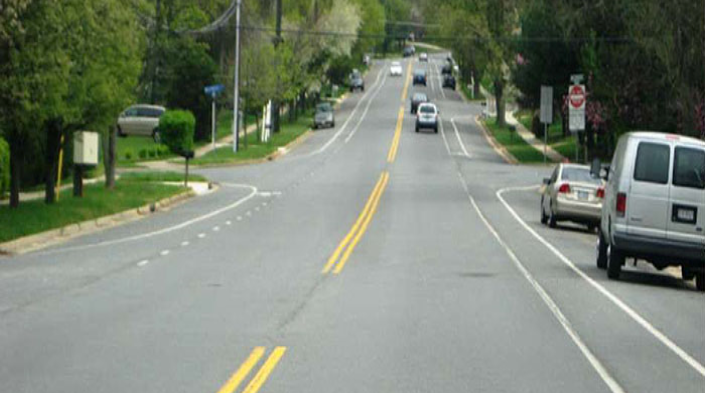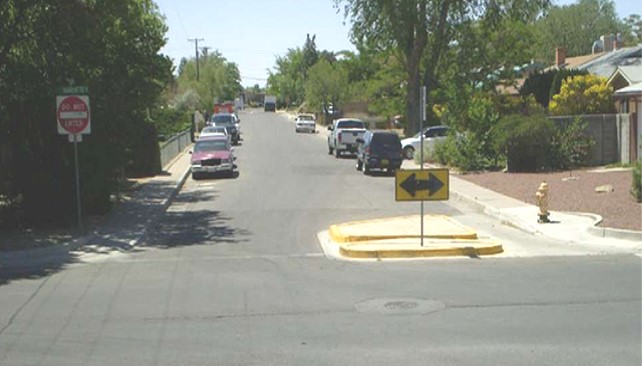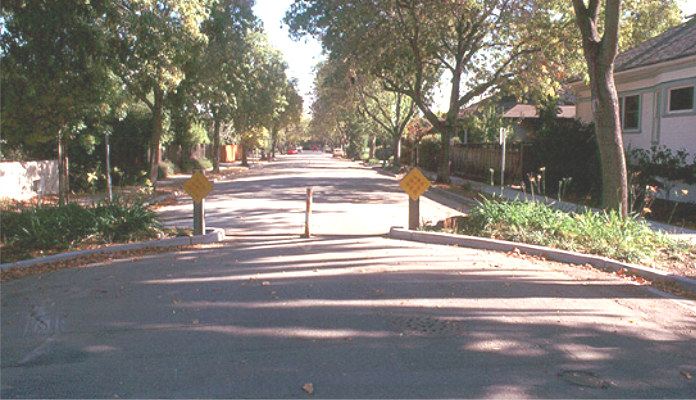Overview
Cities can reduce traffic speeds by using traffic management techniques. Certain speed controls alter the configuration of a roadway, and others change how people psychologically respond to a street. Traffic management measures are grouped into four categories: horizontal deflection, vertical deflection, street width reduction, and routing restriction.
Horizontal deflection hinders the ability for a motorist to drive in a straight line by creating a horizontal shift in the roadway. This shift forces a motorist to slow the vehicle in order to comfortably navigate the measure.
Vertical deflection creates a change in the height of the roadway which forces a motorist to slow down to maintain an acceptable level of comfort.
Street width reduction narrows the width of a vehicle travel lane. As a result, a motorist slows the vehicle in order to maintain an acceptable level of comfort and safety. The measure can reduce the distance a pedestrian walks to cross a street, reducing exposure to pedestrian/vehicle conflicts.
Routing restriction prevents particular vehicle movements at an intersection and is intended to eliminate some portions of cut-through traffic.
Speed Cushions
Speed cushions are similar to speed humps, but have wheel cut-out openings to allow large vehicles like buses to pass unaffected while reducing car speeds.

Speed Tables
Speed tables are similar to speed humps, but have a flat top, typically 6 to 9 meters long. When speed tables are combined with pedestrian crossings, at the intersection or mid-block, they are called raised crossings.

Speed Hump
Speed humps are areas of pavement raised three inches in height over a minimum of 12 feet in length. Speed humps have pavement markings, advisory signs and advanced warning signs. They can be used on residential 2-lane local or minor neighborhood collector roadways, with a maximum posted speed limit of 30 mph. It may also be used to deter cut-through traffic.

Median
Medians are raised islands in the center of the roadway that separate traffic directions. Medians are used on wide streets to narrow the travel lanes and ease pedestrian crossings.

Pinchpoint
Chokers or pinchpoints restrict motorists from operating at high speeds on local streets and significantly expand the sidewalk realm for pedestrians.

Chicane
Chicanes create a curved street alignment that can be designed into new developments or retrofitted in existing right-of-ways. The curvilinear alignment requires additional maneuvering and shortens drivers' sight-lines, resulting in lower overall speeds.

Choker
Chokers are raised islands in the parking zone that can be detached from the curb-line to allow for drainage. Mid-block chokers narrow the roadway and are most applicable on wide streets with long blocks having speeding and cut-through problems. Chokers can have the same narrowing effect as parked vehicles on streets where there is little or no on-street parking. Chokers may be installed with either landscaping or hardscape treatment.

Bike Lane
A bike lane is a portion of the road reserved for the exclusive or preferential use for cyclists. Unlike a cycle track, which is physically separated from motor vehicles using the road, a bike lane is delimited by road markings. The space needed for the bike lane is obtained by eliminating one traffic lane, by narrowing one or several lanes, or by eliminating parking spaces for cars.

Road Narrowing
Narrow lanes reduce speeds and minimize crashes on city streets by way of reducing the right-of-way and making drivers wary of traffic and adjacent users. Use the additional space for pedestrian space, cycle facilities, or green infrastructure.

Mini Roundabout
Roundabouts reduce traffic speeds at intersections by requiring motorists to move with caution through conflict points.

Partial Street Closure
A partial street closure is a physical barrier that restricts vehicles from turning into a street, while allowing bicycle access. The adjacent lane is left open to allow vehicles to exit, while two-way traffic is maintained for the remainder of the block. Partial closures can be considered on local streets with cut-through traffic.

Full Street Closure
A full street closure of the street blocks both lanes of travel, so that the street becomes a cul-de-sac. This measure eliminates all through traffic and limits street access to local residents. It is applicable to local streets with major cut-through concerns where an emergency vehicle response route does not exist. The closure location and details are site-specific depending on roadway geometrics and applicable City Ordinances.

Diverter
Diverters are raised areas placed across a four-way intersection that prohibit through movements and force turns for approaches. Diverters can be considered on local streets where cut-through traffic is a major problem. It breaks up the street grid while maintaining permeability for pedestrians and bicyclists.

Signal Progression
Signals timed to a street's target speed can create lower speeds along a corridor.

Building Lines and Street Trees
A dense environment with no significant setbacks constrains sightlines, making drivers more alert and aware of their surroundings. Trees narrow a driver's visual field and create rhythm along the street.

On-Street Parking
On-street parking narrows the street and slows traffic by creating friction for moving vehicles.

Corner Radii
Narrowing corner radii reduces vehicle turning speeds as well as pedestrian crossing distances. It minimizes the size of a corner radius, which is critical to create safe and compact intersections.

Shared Streets
By removing the physical distinctions between pedestrian, cycle, and vehicular spaces, shared street treatments force all users to share the street, increasing awareness and reducing motor vehicle speeds.

Gateway Treatments
Gateway treatments alert drivers that they are entering a slower area. This treatment may include signage, entry portals, speed tables, raised crossings, and curb extensions.

Pavement Materials and Appearance
Pavement appearance can be altered by unique treatments that add visual interest, such as colored or pattern-stamped asphalt, concrete, or concrete pavers. It makes other traffic calming techniques more noticeable to drivers. Pedestrian crossings and intersections can be painted to highlight crossing areas.

2-Way Street
2-way streets, especially those with narrower profiles, encourage motorists to be more cautious and wary of oncoming traffic.

Raised Intersection and Crosswalk
Raised intersections create a safe, slow-speed crossing and public space at minor intersections. Similar to speed humps and other vertical speed control elements, they reinforce slow speeds and encourage motorists to yield to pedestrians at the crosswalk.
